Evidence of Ancient Martian Beaches: Zhurong Rover Reveals Habitable Past

A new study published in the Proceedings of the National Academy of Sciences (PNAS) suggests Mars may have once boasted sun-drenched, sandy beaches with gentle waves. An international team of scientists, including researchers from Penn State, used data from the Zhurong Mars rover to identify subsurface rock layers strongly suggesting an ancient northern ocean. This research provides the clearest evidence yet of a significant body of water and a more habitable environment on Mars. By analyzing subsurface sedimentary deposits, scientists found structures similar to Earth's coastlines, including 'foreshore deposits' formed by tides and waves. This indicates the presence of waves, suggesting a dynamic air-water interface – similar to where Earth's earliest life developed. Other possible origins, like ancient rivers or volcanoes, were ruled out. The discovery supports the hypothesis of a vast Martian ocean and suggests a potentially tens-of-millions-of-years-long warm, wet period suitable for life.